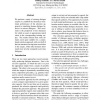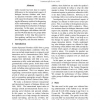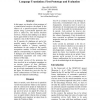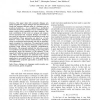118
Voted
AI
2011
Springer
14 years 4 months ago
2011
Springer
In this paper, we learn the components of dialogue POMDP models from data. In particular, we learn the states, observations, as well as transition and observation functions based o...
97
Voted
SIGDIAL
2010
14 years 7 months ago
2010
We perform a study of existing dialogue corpora to establish the theoretical maximum performance of the selection approach to simulating human dialogue behavior in unseen dialogue...
117
Voted
SIGDIAL
2010
14 years 10 months ago
2010
We describe an approach to improving the naturalness of a social dialogue system, Talkie, by adding disfluencies and other content-independent enhancements to synthesized conversa...
93
Voted
SIGDIAL
2010
14 years 10 months ago
2010
Little research has been done to explore differences in the interactional aspects of dialogue between children with Autistic Spectrum Disorder (ASD) and those with typical develop...
112
Voted
EMNLP
2010
14 years 10 months ago
2010
We explore the task of automatically classifying dialogue acts in 1-on-1 online chat forums, an increasingly popular means of providing customer service. In particular, we investi...
103
Voted
ACL
2010
14 years 10 months ago
2010
Current turn-taking approaches for spoken dialogue systems rely on the speaker releasing the turn before the other can take it. This reliance results in restricted interactions th...
144
Voted
SPEECH
2002
15 years 11 days ago
2002
This paper1 discusses the use of `conversational' or `dialogue games' as a basis for building dialogue systems. We give a tutorial overview of some recent attempts to re...
116
Voted
JAIR
2000
15 years 16 days ago
2000
This paper describes a novel method by which a spoken dialogue system can learn to choose an optimal dialogue strategy from its experience interacting with human users. The method...
98
Voted
COLING
2002
15 years 17 days ago
2002
In this paper, we describe a first prototype of a pattern-based analyzer developed in the context of a speech-to-speech translation project using a pivot-based approach (the pivot...
115
Voted
JMM2
2007
15 years 19 days ago
2007
— This paper deals with automatic dialogue acts (DAs) recognition in Czech. Dialogue acts are sentence-level labels that represent different states of a dialogue, such as questio...




